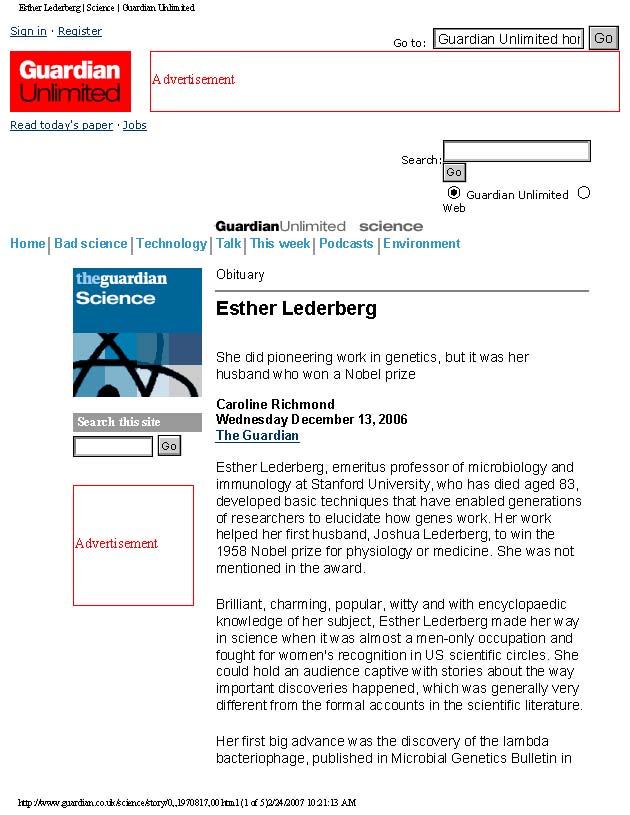Esther Lederberg, emeritus professor of microbiology and immunology at Stanford University, who has died
aged 83, developed basic techniques that have enabled generations of researchers to elucidate how genes
work. Her work helped her first husband, Joshua Lederberg, to win the 1958 Nobel prize for physiology or
medicine. She was not mentioned in the award.
Brilliant, charming, popular, witty and with encyclopaedic
knowledge of her subject, Esther Lederberg made her way in science when it was almost a men-only occupation
and fought for women's recognition in US scientific circles. She could hold an audience captive with
stories about the way important discoveries happened, which was generally very different from the formal
accounts in the scientific literature.
Her first big advance was the discovery of the lambda bacteriophage, published in Microbial Genetics
Bulletin in 1951. Phages are viruses that live in bacteria, and the lambda phage lives in E coli. The
lambda phages became a useful model for studying the biology of all viruses, and an essential tool for
studying gene regulation and genetic recombination. Up to then, the only known bacteriophages were the
lethal sort that invade the bacterium, multiply rapidly and kill it. Lederberg's "temperate" phage was the
first recognised example that lives in bacteria, insinuating itself in the host's DNA. Only when the cell
is stressed, for example by lack of nourishment, does the phage replicate, killing the bacterium.
The lambda phage became the laboratory model for studying animal viruses that have a similar lifestyle,
such as the herpes virus and some tumour viruses. Lederberg discovered it by noticing that some bacterial
colonies looked as if they had been partly eaten. She transferred some of the "eaten" bacteria to another
bacterial plate and discovered they could do the same thing to other bacteria. Her work laid the foundation
for showing how phages can transfer genes between bacteria, how genes are regulated, how pieces of DNA
break apart and recombine, and how the process of making ribonucleic acid (RNA) from DNA is started and
stopped.
In 1952, the Lederbergs formed a team studying bacterial genetics, as this offered an accessible way of
studying how chromosomes behave. They proved that bacteria mutate so rapidly that the changes can be
tracked in the laboratory.
A sterilised square of velvet is pressed on to a bacterial culture in a flat dish, rather like pressing
a rubber stamp on to an ink pad. The velvet is then pressed onto a series of sterile culture plates, each
with different nutrients or antibiotics. By seeing which colonies grow on what plates, the Lederbergs
proved the existence of spontaneous mutations of bacteria. If the replica plate lacked a specific nutrient,
only a mutant able to make that nutrient for itself could flourish. Conversely, if it contained an
antibiotic, only a mutant that was resistant to that antibiotic would flourish. The technique also proved
that antibiotic resistance was already present in the colonies and was not, as many scientists believed,
developed only on exposure to the antibiotic. It was this work which won Joshua Lederberg the Nobel prize.
In the initial experiment that validated the technique, they used the powder puff from Esther's compact.
Before their technique, screening bacteria for a desired mutation involved testing up to 10,000 individual
bacterial colonies.
Born Esther Zimmer into a poor family in the Bronx, she won a place at Hunter College, City University
of New York, intending to study French or literature. To the horror of her teachers, she changed to
biochemistry. After graduating in 1942 she went to Stanford University to study genetics, working part time
as a biology teaching assistant to support herself and supplementing her modest earnings by dining on frogs'
legs from dissection classes.
In 1946, the year she got her master's, she married Joshua, three years younger and already on the staff
of Wisconsin University. She joined him there as his research associate, receiving her doctorate in 1950.
When he went to Stanford as head of genetics in 1959, Esther joined the department of microbiology and
immunology. Shortly afterwards, her second husband recalls, she and two other women went to the dean to
demand he appoint a woman to the faculty. She got the job, for which she was overqualified, because only
she was willing to accept an untenured post.
In 1976, she became director of Stanford's plasmid reference centre (a plasmid is a cluster of phage DNA
within a bacterial cell). She retired in 1985, but continued to work in the plasmid lab.
After her divorce in 1966, she started a group for divorced women at Stanford. She had already founded
the Mid-Peninsula recorder orchestra, and developed her interest in medieval dance, and renaissance and
baroque music. In 1989, an engineer new to Stanford called Matthew Simon went to a meeting and asked if
there was anyone who knew about early music. Esther overheard him. They married in 1993, when she was 70.
He, and her brother Benjamin Zimmer, survive her.
· Esther Miriam Lederberg, microbial geneticist, born December 16 1922; died November 11
2006.


 Website Terms of Use
Website Terms of Use